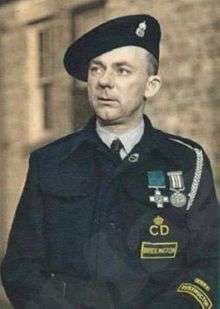Thomas Alderson
| Thomas Alderson | |
|---|---|
 | |
| Born |
15 September 1903 Sunderland, England |
| Died | 28 October 1965 (aged 62) |
| Allegiance |
|
| Service/branch | Air Raid Precautions |
| Rank | Detachment Leader |
| Battles/wars | World War II |
| Awards |
|
| Other work | Marine and local authority engineer |
Thomas Hopper Alderson GC (15 September 1903 – 28 October 1965) was the first person to be directly awarded the George Cross shortly after its creation in 1940.[1] He was an Air Raid Precautions (ARP) warden in Bridlington.
He was fifth of six children. He went first to his local village school and then continued his schooling at Elwick Road senior boys' school, West Hartlepool, becoming Head Boy. During World War I he witnessed the bombardment of West Hartlepool by the German High Seas Fleet on 16 December 1914. After leaving school at 15 he first worked as an office boy and a draughtsman, and then undertook an engineering apprenticeship. He joined the Merchant Navy, becoming a first engineer. Following the birth of his daughter in 1935 he became an engineer for West Hartlepool council. He moved to Bridlington in 1938 as works supervisor for the Corporation. Local authorities were responsible for air raid precautions and trained their own workforces in rescue work. Alderson attended an anti-gas school at Easingwold, near York, and became an instructor in the subject.
He worked as part-time Air Raid Warden, leading a detachment of rescue and demolition parties in Bridlington. The coastal town was soon attacked by Luftwaffe bombers, and residential areas were hit. On three occasions in August 1940 he led rescue teams and entered dangerous buildings to rescue trapped civilians. He was the first person to receive the newly instituted George Cross from the King, and in a radio broadcast of the time insisted that his award was for all the rescue parties in Bridlington. This interview can be heard in full on The Blitz, an audiobook CD of wartime recordings.
In 1946 he joined the East Riding of Yorkshire County Council workforce as an assistant highways surveyor. He then joined the new Civil Defence Corps, this time to protect the civilian population from nuclear warfare, rather than conventional bombs. On 28 October 1965 he died of lung cancer in Northfield hospital at Driffield, Yorkshire. His George Cross is on display at the Imperial War Museum where it can be seen with a medal from the RSPCA, awarded later in the war for rescuing two horses from a burning stable.[2]
Citation
The London Gazette citation appeared in a supplement to the issue of 27 September 1940, dated 30 September 1940:[3]
| “ | A pair of semi-detached houses at Bridlington was totally demolished in a recent air raid. One woman was trapped alive. Alderson tunnelled under unsafe wreckage and rescued the trapped person without further injury to her.
Some days later, two five-storey buildings were totally demolished and debris penetrated into a cellar in which eleven persons were trapped. Six persons in one cellar, which had completely given way, were buried under debris. Alderson partly effected entrance to this cellar by tunnelling 13 to 14 feet under the main heap of wreckage and for three and a half hours he worked unceasingly in an exceedingly cramped condition. Although considerably bruised he succeeded in releasing all the trapped persons without further injury to themselves. The wreckage was unsafe and further falls were anticipated; coal gas leaks were of a serious nature and there was danger of flooding from fractured water pipes. Despite these dangers and enemy aircraft overhead the rescue work was continued. On a third occasion some four-storey buildings were totally demolished. Five persons were trapped in a cellar. Alderson led the rescue work in excavating a tunnel from the pavement through the foundations to the cellar; he also personally tunnelled under the wreckage many feet into the cellar and rescued alive two persons (one of whom subsequently died) from under a massive refrigerator, which was in danger of further collapse as debris was removed. A wall, three storeys high, which swayed in the gusty wind, was directly over the position where the rescue party were working. This was likely to collapse at any moment. Alderson worked almost continuously under the wreckage for five hours, during which time further air raid warnings were received and enemy aircraft heard overhead. By his courage and devotion to duty without the slightest regard for his own safety, he set a fine example to the members of his Rescue Party, and their team work is worthy of the highest praise. |
” |
See also
- List of George Cross recipients
- Hissey, Terry – Come if ye Dare – The Civil Defence George Crosses, (2008), Civil Defence Assn (ISBN 9780955015328)
- T.H. Alderson interview (1940) on The Blitz audiobook
References
- ↑ "Thomas Alderson, GC". George Cross database. Archived from the original on 16 November 2007. Retrieved 19 November 2007.
- ↑ Woolven, Robin (May 2005). "'Alderson, Thomas Hopper (1903–1965)'". Oxford Dictionary of National Biography. Oxford University Press. doi:10.1093/ref:odnb/92614. Retrieved 24 November 2007. (subscription required (help)).
- ↑ The London Gazette: (Supplement) no. 34956. p. 5767. 27 September 1940. Retrieved 24 November 2007.